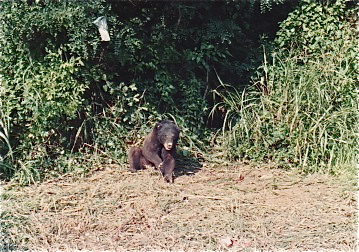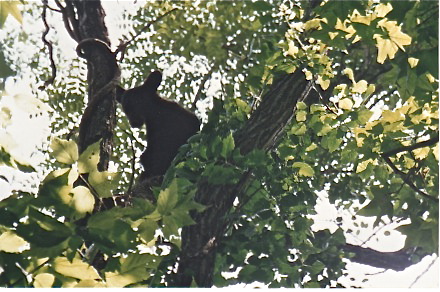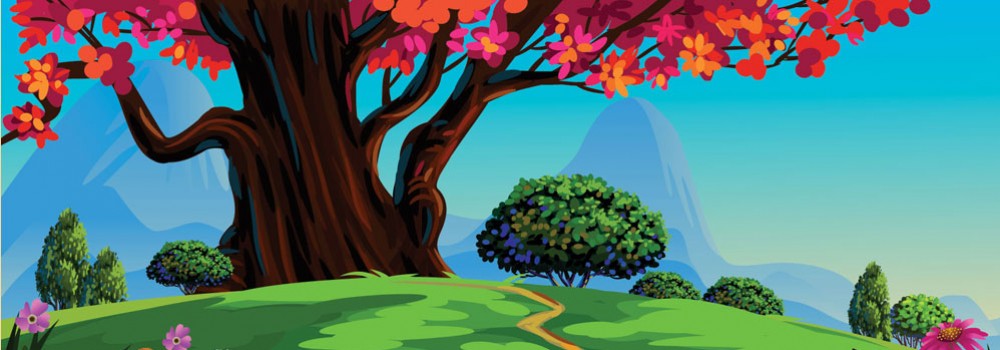In an earlier post, I said that one thing always leads to another along the reading road, a.k.a., my life. Mental meandering has so often become fascination, so “over the river and through the woods” from black bears to bumblebees seems natural. Good science requires time and patience; getting to the last page isn’t exactly instant gratification. It’s more like a treasure hunt where you have to dream, delve, and, often, literally dig in the dirt. Complicating all this is the fact that I have a family, with all the maintenance, surprises, holidays, advice given and taken or not, and daily love which often present detours around any other project underway. During all the stirring of pots and bandaging of bumps, thoughts and curiosity tug and won’t leave, ever.
A few years ago, I returned to academic life and jumped into a course in environmental literature. While reading and researching, I began to think about black bears with their history and their present state. Their decline affects so much more than the bears, themselves. A phone call put me in touch with a wildlife biologist who introduced me to a couple of experts studying bears in other states, and we began a five-year discourse, including particular details of radio-collared bears and others in the wild. I tried not to be side-tracked by more creatures, like birds and bees, but habitats in two states were a big playground/discovery center for me. I couldn’t know that this would lead to a rare invitation to accompany biologists into the field one summer to capture a black bear. Armed with hundreds of facts and years of study, I joined them in Tensas National Wildlife Preserve in northern Louisiana. My husband, Jim, carried my cameras and field equipment, and off we went.
Our ATV rumbled along through dense brush beneath towering old giants of oak, American elm, green ash and sweet gum. Palmettos had been grouped to form a path to a brush-covered foot snare that would not harm the bear. A nearby paw-paw tree yielded its melon-shaped fruit as well as a sack of raspberry scent (visible in the photo below). The coup de maître were honeybuns hung from trees and scattered in the brush just beyond the snare. With five traps laid, would luck be with us?
Anticipation was palpable that early morning. After finding the first trap empty, we moved on toward the second a few miles away. We found bear tracks crisscrossed with raccoon tracks parallel to a row of randomly bent corn stalks and nibbled cobs along a corn field bordering the woods. Around a bend, suddenly, “There she is!” A female black bear had flattened a 15-foot circle of brush permitted by the length of her snare attachment and sat in the middle registering typical displeasure by an intermittent snapping of the jaws and blowing with the lips. Then noises in the brush directed us toward a huge elm about 20 feet into the dense embankment above a crook of a tributary of the Tensas River. We watched a fuzzy cub heed its mother’s guttural signals and scamper to a vantage point on a limb about 25 feet up the trunk. A small, solid black head would alternately peek and retreat behind the limb, tiny ears at attention. We judged it to be about five months old, and approximately 15 pounds – about the size of a cocker spaniel.

Female black bear secured by foot snare. Note raspberry scent sack in tree.

Black bear cub
We needed to work fast so Mother Bear could return to nursery duty. We tranquilized her with a dart, examined, weighed and measured, and then outfitted her with a radio collar for tracking and further research. Care was taken to allow for any weight gain before the collar would wear away in a year or two. A glance up to the leaf canopy revealed a fast-asleep cub stretched out full-length, squirrel-fashion, belly flush and four legs limply dangling from either side of the limb. I knew there were yet a couple of fleeting minutes for me to rub the head and back of this wild creature in repose — silent minutes eloquent enough to convey to the most skeptical the value of preserving its kind, indicator of the well-being of so many other species of our forests and, ultimately, man. There is much more about this day, and my longer account was published in the Louisiana Conservationist magazine.

Me, with female black bear
Not letting go of black bears, and that one special black bear, fast forward a few years through new technology and new ways of communicating and publishing. One sleepy spring morning along the Mississippi Gulf Coast, I opened the back porch door and was overcome with the fragrance of blossoms, the incessant hum of an undulating halo of bumblebees around our Meyer lemon tree, the music of water spilling over the fountain bowls. I forgot breakfast, grabbed my camera, and that’s how my first ebook was born. The words wrote themselves in my head, and I forced myself to turn back to the house to write the story for children, to help them understand. They need to know that without these quiet, ongoing activities underfoot, out of sight, on the wing, here and gone in the space of moments, we would not exist. It really wasn’t such a stretch from black bears to bumblebees. It was logical/magical.
I hope you’ll let yourself enter the world with new eyes. Grab a book about what catches your imagination, really see, walk and hunt, poke under things, ask questions and find answers. There are friends connected to those answers. You will be comforted, surprised, thrilled. It works. Whether black bears to bumblebees, or anything else, you’ll see how everything is truly connected. You’ll make sense of your happy unlikelihoods!



